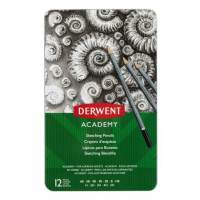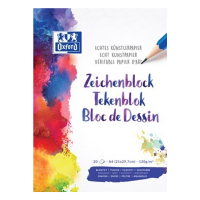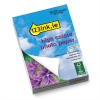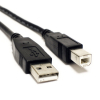- Over 400,000 clients!
- Nationwide delivery from €4.99 (max €6.99)
This site is protected by reCAPTCHA and the Google
Privacy Policy and
Terms of Service apply.
Pencil hardness
.png)
Understanding pencil lead grades is important when choosing the right pencil. Whether you’re a wordsmith or an artist, the correct pencil hardness can enhance your creative process or the quality of your work. Pencils are one of the most common writing and drawing tools that come in various sizes, shapes, and colours. Pencil hardness refers to the resistance of the pencil lead to wear and tear in how it is applied through writing and drawing onto surfaces.

The letters are classified as either soft black (B), hard (H), hard black (HB), or firm (F). The degree of soft black, hard, hard black, and firm are then further classified by numbers. The higher the number the higher the intensity. The harder the pencil the longer the mark lasts, as it leaves less lead on a surface. The softer the pencil the darker and softer the mark. Other factors can affect pencil hardness, such as the pressure applied while writing, the angle of the pencil, and the type of paper used.
.png)
The pencil hardness scale is important for artists, writers, designers and many other professions. Understanding and choosing the right pencil from the scale ensures optimal results in the application of pencils in professional work.
Harder pencils (2H-9H) are most suitable for technical drawing, drafting, and fine details. Hard (H) light produces a more precise line that is also easy to erase. Black (HB-9B) pencils are commonly used for sketching, shading, and artistic drawing. They produce a darker and bolder line that is harder to erase. A drawing set containing all pencil hardness ensures you can achieve both fine detail and shading work in your drawings.
This scale is universal and essential across many industries. Mastering and understanding this scale is important for guiding professionals towards the perfect pencil.

Pencils are important tools not just in creative fields but also construction, architecture and engineering. Pencils are a versatile and adaptable tool making it essential across many sectors and industries.
Many factors are worth considering when choosing pencil hardness. Factors like pressure of use, do you have a heavy hand or a lighter touch? A heavier hand may require a softer lead. Paper type is important, rough paper requires harder pencils and smooth paper works best with soft lead pencils. If you are using pencils for drawing darker and softer pencils are ideal for adding contrast and shadows. Lighter and harder softer pencils are perfect if you wish to plan or map out drawings.
How is pencil hardness determined?
2B or not 2B? Pencil hardness is determined by the type of graphite used in the lead inside your pencil. Graphite is easily moulded into thin rods that are placed into the inside of pencils. The hardness of graphite depends on its composition as a result of the pressure and temperature under which it was formed. This results in different grades of graphite, through the use of both numbers and letters of pencils.
The letters are classified as either soft black (B), hard (H), hard black (HB), or firm (F). The degree of soft black, hard, hard black, and firm are then further classified by numbers. The higher the number the higher the intensity. The harder the pencil the longer the mark lasts, as it leaves less lead on a surface. The softer the pencil the darker and softer the mark. Other factors can affect pencil hardness, such as the pressure applied while writing, the angle of the pencil, and the type of paper used.
.png)
The pencil hardness scale is important for artists, writers, designers and many other professions. Understanding and choosing the right pencil from the scale ensures optimal results in the application of pencils in professional work.
Best Pencil Hardness for Writing
Harder pencils are most suitable for writing as they produce thin finer lines. Harder ‘H’ pencils produce clear and precise writing. These harder pencils are ideal for drafting and filling out forms. Mechanical pencils can be useful when writing quick notes in a rush as there is no need for use of a pencil sharpener. Mechanical pencils come in the same lead hardness range as traditional pencils.Best Pencil Hardness for Drawing
The choice of pencil hardness depends on use and personal preference. For example, an artist may prefer a softer pencil for sketching and shading, while an engineer may prefer a harder pencil for precise technical drawings. It is also common for people to use a range of pencil grades for different parts of their drawings.Harder pencils (2H-9H) are most suitable for technical drawing, drafting, and fine details. Hard (H) light produces a more precise line that is also easy to erase. Black (HB-9B) pencils are commonly used for sketching, shading, and artistic drawing. They produce a darker and bolder line that is harder to erase. A drawing set containing all pencil hardness ensures you can achieve both fine detail and shading work in your drawings.
Different industries that use pencils
Pencils are the ultimate tool for those who create. Pencils can be used for anything from marking surfaces, drawing construction plans, solving puzzles, taking notes, writing lists, drawing and sketching to marking carpentry measurements.It’s not just artists and illustrators who use pencils as a primary tool, many other professions include: carpenters, engineers, architects, students, surveyors, drafters, graphic designers, animators and writers.
| Industry | Application |
| Automotive | For applying to clear coats and painted surface on cars |
| Writing & journalism | For taking quick notes, interviews and writing articles |
| Carpentry | For making measurements and guidelines |
| Architecture | Pencils are used to sketch buildings and create |
| Engineering | For making sketches and technical drawings |
| Fashion | For sketching designs and illustrations |
| Graphic Design | For planning concepts and brainstorming |
| Art | For drawing, sketching and planning paintings |
This scale is universal and essential across many industries. Mastering and understanding this scale is important for guiding professionals towards the perfect pencil.
Pencils are important tools not just in creative fields but also construction, architecture and engineering. Pencils are a versatile and adaptable tool making it essential across many sectors and industries.
Pencil lead grading scale
The hardness of pencils is rated on a standardised scale known as the "pencil grading scale." This scale ranges from 9H (the hardest) to 9B (the softest), with HB being the midpoint of the scale. The H in 9H stands for "hard" and the B in 9B stands for "black," as softer pencils produce darker lines. The table below lists the different hardness and their uses:| Hardness Scale | Pencil hardness | Pencil mark types |
Pencil Uses |
| 9B | Extremely soft | Very soft, very dark marks | Artistic designs |
| 8B | Extremely soft | Extremely soft, very dark marks | Artistic designs |
| 7B | Extremely soft | Extra soft, very dark marks | Artistic designs |
| 6B | Soft | Very soft, very dark marks | Artistic designs and drafts |
| 5B | Soft | Soft, dark marks | Artistic designs and drafts |
| 4B | Soft | Soft, dark marks | Artistic designs and drafts |
| 3B | Soft | Soft, dark marks | Drawing |
| 2B | Soft | Moderately soft, medium-dark marks | Drawing and writing |
| B | Soft | Soft, medium-dark marks | Drawing and writing |
| HB | Medium hard | Medium, standard grade | Drawing and writing |
| F | Medium hard | Firm, medium marks | Drawing and writing |
| H | Hard | Hard, medium marks | Graphic, technical drawing and writing |
| 2H | Hard | Moderately hard, medium-light marks | Graphic, technical drawing and writing |
| 3H | Hard | Hard, medium-light marks | Graphic, technical drawing and writing |
| 4H | Hard | Moderately hard, light marks | Graphic, technical drawing and writing |
| 5H | Hard | Hard, light marks | Graphic, technical drawing and writing |
| 6H | Extremely hard | Very hard, light marks | Technical drawing, cartography and lithography |
| 7H | Extremely hard | Extra hard, light marks | Technical drawing, cartography and lithography |
| 8H | Extremely hard | Extremely hard, light marks | Technical drawing, cartography and lithography |
| 9H | Extremely hard | Extremely hard, light marks | Technical drawing, cartography and lithography |
Many factors are worth considering when choosing pencil hardness. Factors like pressure of use, do you have a heavy hand or a lighter touch? A heavier hand may require a softer lead. Paper type is important, rough paper requires harder pencils and smooth paper works best with soft lead pencils. If you are using pencils for drawing darker and softer pencils are ideal for adding contrast and shadows. Lighter and harder softer pencils are perfect if you wish to plan or map out drawings.
Popular Products
Common questions
Is HB or 2B better for writing?
How are pencils different in hardness?
Pencils vary in hardness due to what their graphite core composition are made of. Hard pencils (H) create lighter lines. Bold pencils (B) produce darker lines. Pencil hardness is determined by the graphite-to-clay ratio. More graphite (B) creates soft, dark lines, while more clay (H) yields harder and lighter lines.
What is the order of pencil hardness?
Pencils are graded from 9H (hardest) to 9B (softest). The order of pencil hardness is from hardest to softest: 9H, 8H, 7H, 6H, 5H, 4H, 3H, 2H, H, F, HB, B, 2B, 3B, 4B, 5B, 6B, 7B, 8B, 9B.
What pencil is harder: H or B?
H pencils are harder than B pencils. The ‘H’ stands for hard meaning that H pencils create lighter and harder lines. B pencils are less hard due to their higher carbon content producing bolder, darker and softer lines. Unleash your creativity onto almost any surface. POSCA pens allow you to transform everyday objects into works of art! Renowned for their permanence, these POSCA paint pens can create artworks that stand the test of time. No matter the medium your creation will have long-lasting results.Is HB or 2B better for writing?
‘H’ and ‘B’ indicate the pencils' core hardness. Pencils that are marked with the letter ‘H’ contain graphite that is harder resulting in lighter lines. Pencils that are marked with the letter ‘B’ contain graphite that is bolder and softer resulting in darker lines. The hardness scale spans from H to B.
What does H and B mean?
‘H’ and ‘B’ indicate the pencils' core hardness. Pencils that are marked with the letter ‘H’ contain graphite that is harder resulting in lighter lines. Pencils that are marked with the letter ‘B’ contain graphite that is bolder and softer resulting in darker lines. The hardness scale spans from H to B.
How hard is a 6H pencil?
The 6H pencil is very hard and very light. It is harder than a 4H and 2H pencil as it falls towards the end of the pencil hardness scale. The 6 signifies that it is 6 steps harder than a standard midpoint HB pencil. The 6H pencil is the preferred pencil by engineers and architects as it produces minimal, fine and light lines.
Is it hard to use a mechanical pencil?
No, some find it more comfortable to use mechanical pencils as they are convenient to use due to their line consistency, precision, erasability and no need for sharpening. Mechanical pencils are an excellent choice for taking quick notes and with the additional convenience of not having to use a pencil sharpener to save time.
Contact us with any questions!
When selecting pencil hardness, consider your writing style, paper in use and the specific task you’ll be using the pencil for. Now that you know about the difference between H and B pencils and the importance of understanding pencil hardness, you can effectively use pencils in your day to day. Explore our range of pencils, graphite, mechanical pencils and other drawing materials. If you have any further questions do not hesitate to get in touch!| Derwent Academy sketch pencils (12-pack) | ||
|
|
||
|
€8.50
€6.91 Excl. 23% VAT
|
EU warehouse
|
|
| Oxford A4 drawing pad (20 sheets) | ||
|
|
||
| Order now, we can ship this today! | ||
|
€3.95
€3.21 Excl. 23% VAT
|
In stock
|
|


















